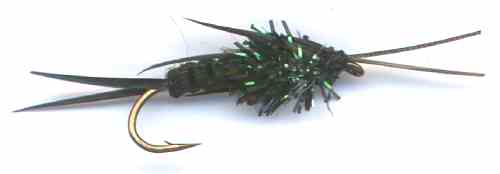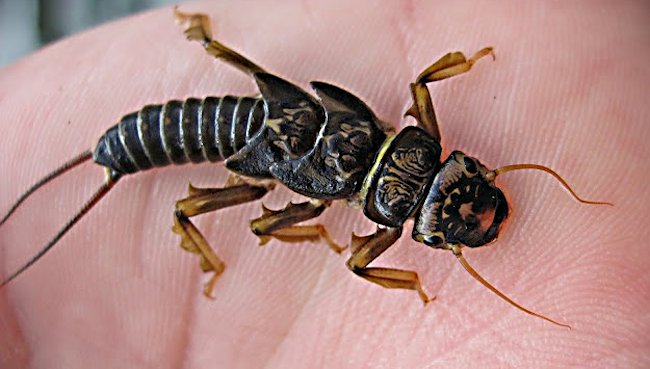The Black Crystal Stonefly Nymph
There are around 500 species of stoneflies recorded in North America. On my last fishing trip to Eastern Canada I noted that it had over 110 varieties. It was here that I caught my first trout on a stonefly nymph back in the 1990’s.

STONEFLY NYMPH FLY PATTERNS. Hook size 10 - $US each
Stonefly nymphs vary quite considerably in size. They range from 5mm to 60mm in length. On a road trip in Pennsylvania, whilst going for an evening walk along the river, something big and back flew into my head. I swatted it and was amazed to see that it was an insect that had over 6 inch wing span. We have nothing like this in Britain. My fly fishing NYPD detective friend who was travelling with me, identified the insect as the Giant Black Stonefly. This thing was the size of a small bird. It’s nymphs are normally very large and highly regarded by rainbow and brown trout. They can spend two winters exploring the river bed for food so that they can grow to the correct size needed to hatch into an adult stonefly.

Although there are lots of different species, not all of them are important to the fly fisherman. The ones that are widespread and the most numerous are the flies to carry imitation of in your tackle bag. All the different stoneflies have long Latin scientific names. Most are known locally by their common names like, Great Brown, Giant Black, Early Black, Early Brown, Willowfly, Yellow Sally, Green Stonefly, Golden stonefly and the Eastern Stonefly Creeper. Some species share the same common name. Some stoneflies have different names depending on what part of North America you are fly fishing. What is noticeable is the amount of stoneflies that include the words brown or black in their name. Having a selection of brown and black stonefly nymphs in a few different sizes is always a good plan.
These nymph flies are traditionally fished on a short dropper tied under a strike indicator or large buoyant dry fly. Stoneflies crawl around the river bed and occasionally get washed away downstream when they stumble into areas of faster current. They drift just above the river or stream bottom until they are able to touch bottom again. They do not swim very well. You should try to imitate this scenario by dead drifting your artificial stonefly nymph a few inches above the bottom. You can also fish a team of stoneflies on droppers spaced about 18 inches apart. Put the bigger heavier fly on point so you do not get tangles when you cast your flies and the line hangs correctly at around 90 degrees to the water surface.
This type of team of flies works well on smallmouth bass who rarely feed on the surface after the first few late summer cold evenings. A pair of black stonefly nymphs dead drifted in the deeper water along structures parallel to the current I have found to be very productive.
CUSTOMER'S COMMENT
Australia is still in drought and the creeks and streams I fish are shut down so I have been fishing the dam which is at 42% and falling. The black stonefly nymphs I purchased off you you caught the fish the biggest being a three and a half pounded rainbow trout. Hope we get some rain soon as things don't look good. I was the only fisho who caught any fish and your flies were the difference. Thanks mate, tight lines. Peter Wilson, Australia

